|
LINKS
 Back to my Woodworking Projects Page. Back to my Woodworking Projects Page.
 Back to my Woodworking Page. Back to my Woodworking Page.
 Back to my Homepage. Back to my Homepage.
 My Timberframe Cabin Page. My Timberframe Cabin Page.
|

My First Bench
My first bench was a european style bench with a tail vise and a shoulder vise. The latter has yet to be installed (as you can see in the photos). The tail vise, on the other hand has been installed several times, or to put it a bit differently, I have had three different tail vises on the end of my bench. More on that later. The bench itself is made mostly of maple with some birch, poplar and walnut for a part here or there. It is the standard L-shape, with a tool tray along the rear of the bench. The top is laminated maple with maple endcaps fastened crosswise, bolted in only one location to allow for seasonal wood movement. The legs themselves are a trestle secured by bolts through the stretchers. A picture of the bench can be viewed at the top of this page.
So why have I used three different tail vises on one bench? Since I have two rows of benchdog holes running down the bench on either side of the top, I wanted a vise with two holes corresponding to each row of dogholes. To do this I made a wooden jaw to hold the dogs, and then attached it to a standard face vise to provide the movement and clamping action. The result was pretty terrible racking whenever I used only one dog, since the vise screw did not line up with the dog holes. I tried again with a more substantial quick release vise I found at a garage sale. This was more serviceable, but the racking was still there. Then I got an Emmert patternmaker's vise. This vise was not really appropriate to this bench. So I started building a new bench, which turned out to need a vise for the front in addition to the Emmert. I decided to use the quick release vise from my old bench and to spring for the Veritas twin screw vise to replace it as the tail vise on my first bench.
As I said, I bought the Veritas twin-screw for the tailvise. The only trouble was it needs six inch deep front and back jaws and my endcaps and old vise jaw were closer to four inches. The instructions suggest just adding a new back jaw over the old end of the bench, but it seemed to me that this would make the bench look ungainly. Instead I proceeded to mortise and relaminate the existing endcap to a new depth of 7 inches without increasing its thickness. The trick was to do this without damaging the dovetails that hold the endcaps to the bench. And, while I was at that, I decided to make an entirely new front jaw for the vise rather than modify the old one. You can see how that turned out in the photos above and below, especially the view from the front of the workbench.
A Modification to the Twin-screw Vise
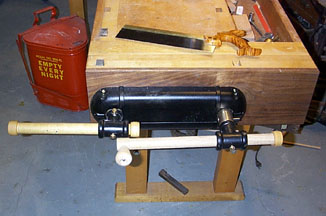 I wrote the above a couple of years back. Since then I have inherited and set up my father's metal lathe. This allowed me to cut down the screw I had for use in the shoulder vise, and finally to install it some 15 odd years after commencing construction of the bench. It also allowed me to make some modifications to the Lee Valley Veritas vise, in light of experience using it for a few years. I'm overall happy with it, but I noticed a few inconveniences. Since the twin screws on the vise had to be somewhat close together to fit on my bench, I had to shorten the lengths of the handles to keep them from hitting one another. Even then, I had to be aware of how handles the were oriented relative to one another to keep from bashing them or my hands. I got tired of this, and I wished I could use a longer handle for some more leverage.
I wrote the above a couple of years back. Since then I have inherited and set up my father's metal lathe. This allowed me to cut down the screw I had for use in the shoulder vise, and finally to install it some 15 odd years after commencing construction of the bench. It also allowed me to make some modifications to the Lee Valley Veritas vise, in light of experience using it for a few years. I'm overall happy with it, but I noticed a few inconveniences. Since the twin screws on the vise had to be somewhat close together to fit on my bench, I had to shorten the lengths of the handles to keep them from hitting one another. Even then, I had to be aware of how handles the were oriented relative to one another to keep from bashing them or my hands. I got tired of this, and I wished I could use a longer handle for some more leverage.
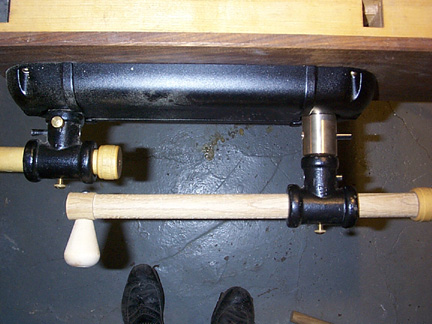 It occured to me that I would be better off if the handles were staggered so that they were different distance from the bench. So after giving it some thought, I turned an extension piece out of brass on my father's metal lathe. The second photo shows the part pretty well. It has a hole in one end that fits over the existing screw shaft and attaches with a pin in the same way the old crank casting fit on this shaft. (The pin is left part way out as Lee Valley recomends so that excessive force will break the pin and not some more important part.) On the other end, I turned down the diameter of the piece so that is is the same as the shaft diameter so that it can fit inside the crank casting just as the screw shaft used to. This section too was drilled for a pin, which lines up with the other one. I lucked out and got both my holes to align perfectly with the existing holes in the original vise parts. Everything works very well. The brass piece is beefy enough to work fine without any noticeable flex or play. I can now put as long a handle as I want on the screw with the adapter piece. I'm satisfied and happy.
It occured to me that I would be better off if the handles were staggered so that they were different distance from the bench. So after giving it some thought, I turned an extension piece out of brass on my father's metal lathe. The second photo shows the part pretty well. It has a hole in one end that fits over the existing screw shaft and attaches with a pin in the same way the old crank casting fit on this shaft. (The pin is left part way out as Lee Valley recomends so that excessive force will break the pin and not some more important part.) On the other end, I turned down the diameter of the piece so that is is the same as the shaft diameter so that it can fit inside the crank casting just as the screw shaft used to. This section too was drilled for a pin, which lines up with the other one. I lucked out and got both my holes to align perfectly with the existing holes in the original vise parts. Everything works very well. The brass piece is beefy enough to work fine without any noticeable flex or play. I can now put as long a handle as I want on the screw with the adapter piece. I'm satisfied and happy.
Another modification came about because I never liked the cheesy plastic cover. So I bought a piece of 4 inch diameter copper pipe to make a replacement. But before I did, Veritas came out with a new cast cover and I purchased it from them rather than make my own.

My Second Bench
As I said, my newly scavanged Emmert patternmaker's vise needed a bench. Lucky for me, I was able to pick up a laminated maple benchtop for about $35 at an auction. All I needed now were legs and skirts to go around the ends and front and rear edges. Rather than build another trestle, I sprung for a set of cast iron legs from Lee Valley, which together with some maple stretchers made a fine trestle with a bit less work for me. For the bench to function well with the vises, it needed dogholes, something not supplied with the benchtop, at least not where I wanted them. But mortising traditional square holes was going to be a lot of work. Instead I used a brace and bit to drill 3/4 inch holes in the top, lined up with the dogs on the vises, and spaced 6 inches apart. These holes fit round brass bench dogs I bought also through Lee Valley.
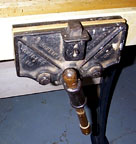 The old vise (on the new bench).
The old vise (on the new bench).
I planed the top as well as I could to remove the polyurethane it came covered in, and to get out the marks of years of use in a Junior High School (the previous home of the main bench slab). Junior high kids being what they are, I kept running into embedded nails. My Spiers infill smooth plane planed through them well enough, but not without nicking the blade. So I ended up quitting while there was still some siginficant tearout in the bench top. Then I covered the whole thing with three coats of tung oil, the first thinned with naptha, the second full strength, and the last a coat of "boiled" tung oil including driers for a somewhat harder finish.
Emmert Patternmaker's Vises
If you are unfamiliar with patternmaker's vises, they are really marvels of versatility. They allow a patternmaker to hold the work at almost any angle in almost any position. That's because the vise both swings upward on its mounting bracket, and turns 360 degrees. Combining the two modes creates a large variety of clamping positions. The vise also has dogs to allow work to be clamped between the vise dogs and dogs set into the dogholes in the tabletop. The accompanying pictures should illustrate some of the positions that the vise can hold work.
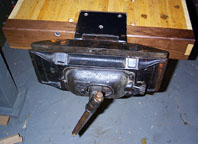 The vise in horizontal position which will allow clamping between the benchdogs and vise dogs.
The vise in horizontal position which will allow clamping between the benchdogs and vise dogs.
 The vise positioned vertically. The vise positioned vertically.
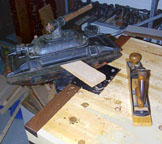 The vise tilted up and rotated 45 degrees.
The vise tilted up and rotated 45 degrees.
The vise also allows clamping of a wide range of shapes. The vise's he front jaw skews to accept odd shaped work. And to top that off, Emmerts came with a tilting plate to further increase the variety of odd shapes that could be held in the vise. Usually these are missing, so it is lucky that Patrick Leach has gone into production making replacements. A picture of the tilt-plate is displayed immediately below.
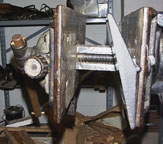 This is the new copy of the original Emmert tilt-plate that I got from
Superior Toolworks.
This is the new copy of the original Emmert tilt-plate that I got from
Superior Toolworks.
The Emmert on my bench is the old style model, affectionately known as the "turtleback" model. Newer Emmerts have a different sort of cam arrangement for skewing the front jaw and hence do not require a cover over the mechanism. John Gunterman has a picture of one of those on his
"Shavings" Homepage
. More importantly, his page has the instructions for mounting the second model on a workbench, as well as some other nice workbench related stuff.
|
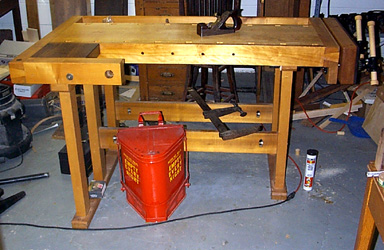 In the past 15 odd years I have made two workbenches, though the first one is still a work in progress. A couple of years ago, in response to a query about benchmaking, I posted a short history of the still unfinished bench up until that point on the Oldtools mailing list. That story, along with a number of other bench stories are now archived at Rick Manderscheid's archive of bench success stories.
Here, I'll update you on the saga of that bench and tell you a bit about my second bench.
In the past 15 odd years I have made two workbenches, though the first one is still a work in progress. A couple of years ago, in response to a query about benchmaking, I posted a short history of the still unfinished bench up until that point on the Oldtools mailing list. That story, along with a number of other bench stories are now archived at Rick Manderscheid's archive of bench success stories.
Here, I'll update you on the saga of that bench and tell you a bit about my second bench.
 Back to my Woodworking Projects Page.
Back to my Woodworking Projects Page.
 Back to my Woodworking Page.
Back to my Woodworking Page.
 Back to my Homepage.
Back to my Homepage.
 My Timberframe Cabin Page.
My Timberframe Cabin Page. 
 I wrote the above a couple of years back. Since then I have inherited and set up my father's metal lathe. This allowed me to cut down the screw I had for use in the shoulder vise, and finally to install it some 15 odd years after commencing construction of the bench. It also allowed me to make some modifications to the Lee Valley Veritas vise, in light of experience using it for a few years. I'm overall happy with it, but I noticed a few inconveniences. Since the twin screws on the vise had to be somewhat close together to fit on my bench, I had to shorten the lengths of the handles to keep them from hitting one another. Even then, I had to be aware of how handles the were oriented relative to one another to keep from bashing them or my hands. I got tired of this, and I wished I could use a longer handle for some more leverage.
I wrote the above a couple of years back. Since then I have inherited and set up my father's metal lathe. This allowed me to cut down the screw I had for use in the shoulder vise, and finally to install it some 15 odd years after commencing construction of the bench. It also allowed me to make some modifications to the Lee Valley Veritas vise, in light of experience using it for a few years. I'm overall happy with it, but I noticed a few inconveniences. Since the twin screws on the vise had to be somewhat close together to fit on my bench, I had to shorten the lengths of the handles to keep them from hitting one another. Even then, I had to be aware of how handles the were oriented relative to one another to keep from bashing them or my hands. I got tired of this, and I wished I could use a longer handle for some more leverage.
 It occured to me that I would be better off if the handles were staggered so that they were different distance from the bench. So after giving it some thought, I turned an extension piece out of brass on my father's metal lathe. The second photo shows the part pretty well. It has a hole in one end that fits over the existing screw shaft and attaches with a pin in the same way the old crank casting fit on this shaft. (The pin is left part way out as Lee Valley recomends so that excessive force will break the pin and not some more important part.) On the other end, I turned down the diameter of the piece so that is is the same as the shaft diameter so that it can fit inside the crank casting just as the screw shaft used to. This section too was drilled for a pin, which lines up with the other one. I lucked out and got both my holes to align perfectly with the existing holes in the original vise parts. Everything works very well. The brass piece is beefy enough to work fine without any noticeable flex or play. I can now put as long a handle as I want on the screw with the adapter piece. I'm satisfied and happy.
It occured to me that I would be better off if the handles were staggered so that they were different distance from the bench. So after giving it some thought, I turned an extension piece out of brass on my father's metal lathe. The second photo shows the part pretty well. It has a hole in one end that fits over the existing screw shaft and attaches with a pin in the same way the old crank casting fit on this shaft. (The pin is left part way out as Lee Valley recomends so that excessive force will break the pin and not some more important part.) On the other end, I turned down the diameter of the piece so that is is the same as the shaft diameter so that it can fit inside the crank casting just as the screw shaft used to. This section too was drilled for a pin, which lines up with the other one. I lucked out and got both my holes to align perfectly with the existing holes in the original vise parts. Everything works very well. The brass piece is beefy enough to work fine without any noticeable flex or play. I can now put as long a handle as I want on the screw with the adapter piece. I'm satisfied and happy.

 The old vise (on the new bench).
The old vise (on the new bench).
 The vise in horizontal position which will allow clamping between the benchdogs and vise dogs.
The vise in horizontal position which will allow clamping between the benchdogs and vise dogs.
 The vise positioned vertically.
The vise positioned vertically.
 The vise tilted up and rotated 45 degrees.
The vise tilted up and rotated 45 degrees.
 This is the new copy of the original Emmert tilt-plate that I got from
This is the new copy of the original Emmert tilt-plate that I got from